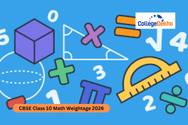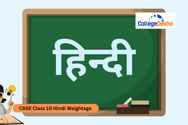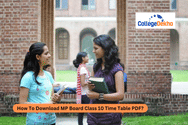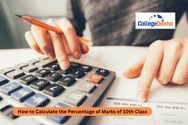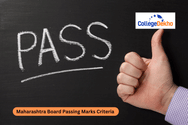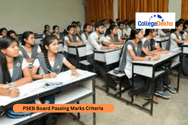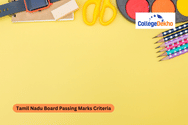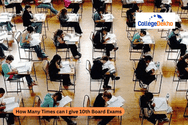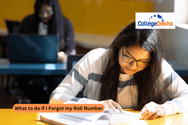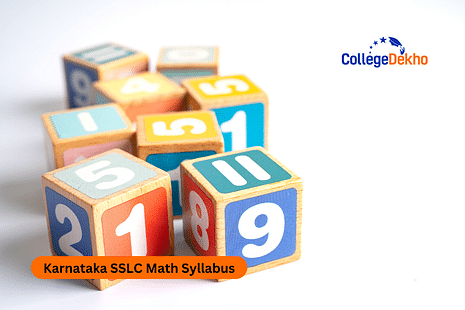

Never Miss an Exam Update
Karnataka SSLC Math Syllabus 2026 includes 15 chapters. The theory paper in Mathematics will be conducted for 80 marks, and the remaining marks are allotted for the internal assessment. Chapters included in the syllabus are Arithmetic Progressions, Triangles, Pair of Linear Equations in Two Variables, Circles, Areas related to Circles, Constructions, Coordinate Geometry, Real Numbers, Polynomials, Quadratic Equations, Introduction to Trigonometry, Some Applications of Trigonometry, Statistics, Probability, and Surface Areas and Volumes. Make sure to also download the Karnataka SSLC Mathematics Exam Pattern 2026 .
After completing the syllabus, pick up the Karnataka SSLC Math Model Paper 2026 . Read more about the Karnataka SSLC Math Syllabus 2026 here:
Karnataka SSLC Math Course Content 2026
The theory paper in Mathematics will be conducted for 80 marks. Refer to the weightage for each chapter from the table given below:
Chapters | Marks |
|---|---|
Arithmetic Progressions | 6 |
Triangles | 8 |
Pair of Linear Equations in Two Variables | 8 |
Circles | 4 |
Areas related to Circles | 3 |
Constructions | 5 |
Coordinate Geometry | 5 |
Real Numbers | 4 |
Polynomials | 6 |
Quadratic Equations | 6 |
Introduction to Trigonometry | 5 |
Some Applications of Trigonometry | 4 |
Statistics | 6 |
Probability | 3 |
Surface Areas and Volumes | 7 |
Karnataka SSLC Math Syllabus 2026
You can refer to the detailed topics included in each chapter from the table given below, according to the latest Karnataka SSLC Math Syllabus 2026:
Chapters | Topics |
|---|---|
Arithmetic Progressions | Motivation for studying Arithmetic Progression: Derivation of the nth term and sum of the first n terms of arithmetic progressions, and their application in solving daily life problems. |
Triangles | Definitions, examples, and counterexamples of similar triangles. (Prove) If a line is drawn parallel to one side of a triangle to intersect the other two sides in distinct points, the other two sides are divided in the same ratio. (Motivate) If a line divides two sides of a triangle in the same ratio, the line is parallel to the third side. (Motivate) If in two triangles, the corresponding angles are equal, their corresponding sides are proportional and the triangles are similar. (Motivate) If the corresponding sides of two triangles are proportional, their corresponding angles are equal and the two triangles are similar. (Motivate) If one angle of a triangle is equal to one angle of another triangle and the sides including these angles are proportional, the two triangles are similar. (Motivate) If a perpendicular is drawn from the vertex of the right angle of a right triangle to the hypotenuse, the triangles on each side of the perpendicular are similar to the whole triangle and to each other. (Prove) The ratio of the areas of two similar triangles is equal to the ratio of the squares of their corresponding sides. (Prove) In a right triangle, the square on the hypotenuse is equal to the sum of the squares on the other two sides. Prove) In a triangle, if the square on one side is equal to the sum of the squares on the other two sides, the angle opposite to the first side is a right angle. |
Pair of Linear Equations in Two Variables | Pair of linear equations in two variables and graphical method of their solution, consistency/inconsistency. Algebraic conditions for number of solutions. Solution of a pair of linear equations in two variables algebraically - by substitution, by elimination, and by cross multiplication method. Simple situational problems. Simple problems on equations reducible to linear equations. |
Circles | Tangent to a circle at, point of contact (Prove) The tangent at any point of a circle is perpendicular to the radius through the point of contact. (Prove) The lengths of tangents drawn from an external point to a circle are equal. |
Areas related to Circles | Motivate the area of a circle; area of sectors and segments of a circle. Problems based on areas and perimeter / circumference of the above said plane figures. (In calculating the area of the segment of a circle, problems should be restricted to a central angle of 60°, 90°, and 120° only. Plane figures involving triangles, simple quadrilaterals and circles should be taken.) |
Constructions | Division of a line segment in a given ratio (internally). Tangents to a circle from a point outside it. Construction of a triangle similar to a given triangle. |
Coordinate Geometry | Only line in two dimensions. Concepts of coordinate geometry, graphs of linear equations. Distance formula. Section formula (internal division). Area of a triangle. |
Real Numbers | Euclid’s division lemma, Fundamental Theorem of Arithmetic - statements after reviewing work done earlier and after illustrating and motivating through examples, Proofs of irrationality of √2, √3, √5 Decimal representation of rational numbers in terms of terminating/non-terminating recurring decimals. |
Polynomials | Zeros of a polynomial. Relationship between zeros and coefficients of quadratic polynomials. Statement and simple problems on division algorithms for polynomials with real coefficients. |
Quadratic Equations | Standard form of a quadratic equation ax2 + bx + c = 0, (a≠0). Solutions of quadratic equations (only real roots) by factorization, and by using quadratic formula. Relationship between discriminant and nature of roots. Situational problems based on quadratic equations related to day to day activities to be incorporated. |
Introduction to Trigonometry | Trigonometric ratios of an acute angle of a right-angled triangle. Proof of their existence (well defined). Values of the trigonometric ratios of 30° , 45°, and 60°. Relationships between the ratios. Trigonometric identities: Proof and applications of the identity sin2 A + cos2 A = 1. Only simple identities to be given. Trigonometric ratios of complementary angles. |
Some Applications of Trigonometry | Simple problems on heights and distances. Problems should not involve more than two right triangles. Angles of elevation / depression should be only 30°, 45°, 60°. |
Statistics | Mean, median, and mode of grouped data (bimodal situation to be avoided). Cumulative frequency graph. |
Probability | Classical definition of probability. Simple problems on finding the probability of an event. |
Surface Areas and Volumes | Surface areas and volumes of combinations of any two of the following: cubes, cuboids, spheres, hemispheres and right circular cylinders/cones. Frustum of a cone. Problems involving converting one type of metallic solid into another and other mixed problems. (Problems with combinations of not more than two different solids can be taken). |
You must download the latest Karnataka SSLC Math Syllabus 2026 as mentioned above and prepare for the exams accordingly. Make sure to check the deleted topics carefully and prepare for the exam accordingly.
Are you feeling lost and unsure about what career path to take after completing 12th standard?
Say goodbye to confusion and hello to a bright future!

FAQs
To revise the Karnataka SSLC Mathematics syllabus 2026 in one day, students should prioritize the topics. They should pay attention to the formulae, and go through the important questions and examples.
Probability and Area Related to Circles are the least important chapters in the Karnataka SSLC Math Syllabus 2026. Students can keep these chapters for the last however do not ignore the chapters because they will guarantee you good marks even with less preparation.
The most important chapters in Karnataka SSLC Math Syllabus 2026 are Triangles, Pair of Linear Equations in Two Variables. Both of these chapters carry 8 marks each which is the highest weight any chapter carries in the syllabus. You must prepare for both chapters with great efficiency.
Karnataka SSLC Math Syllabus 2026 includes chapters like Triangles, Pair of Linear Equations in Two Variables, Surface Areas and Volumes, Statistics, Quadratic Equations, Polynomials, Arithmetic Progressions, Introduction to Trigonometry, Constructions, Coordinate Geometry, Real Numbers, Some Applications of Trigonometry, Probability, and Area Related to Circles.
Karnataka SSLC Math Syllabus 2026 might not be very different from the last year. Students can still check out the previous year's syllabus from the document given here to start the preparations for the board exams and wait for the latest syllabus to be released.
Karnataka SSLC Math Syllabus 2026 will be listed on the official website of Karnataka School Examination And Assessment Board. You have to click on the Documents option and then click on the SSLC option to download the syllabus.
Was this article helpful?








